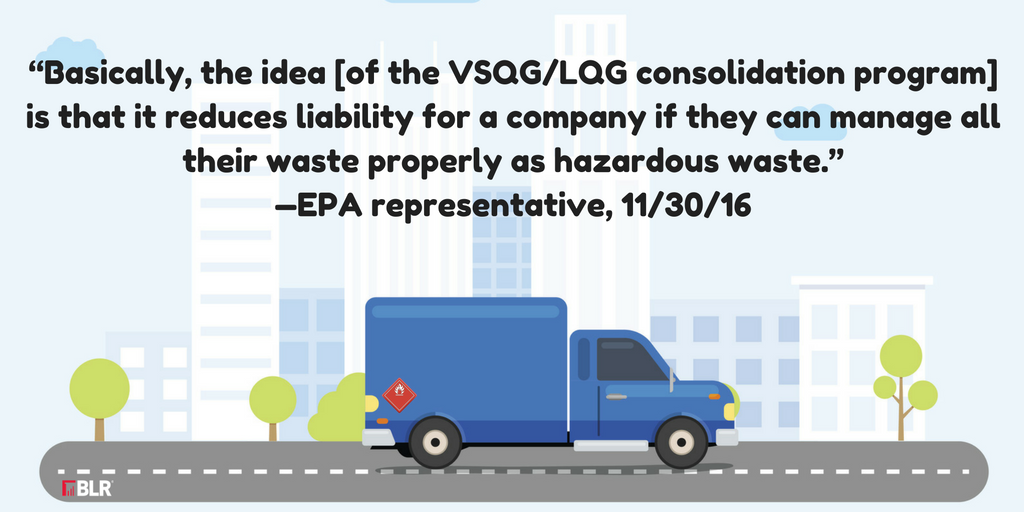The final Hazardous Waste Generator Improvements Rule (Rule), published in the Federal Register on November 28, 2016, contains two of what the U.S. Environmental Protection Agency (EPA) refers to as “voluntary programs”—meaning that generators of hazardous waste have the choice of whether to comply with the new programs’ requirements. The first program is a set of provisions that allows a very small quantity generator (VSQG) (the Rule’s new name for the current “conditionally exempt small quantity generator”) and a small quantity generator (SQG) to maintain their generator class despite a 1-month generation of hazardous waste that exceeds the limit assigned to their class and bumps them up into a larger category of generator.

The second program allows a large quantity generator (LQG) to accumulate on-site without a storage permit the hazardous waste received from a VSQG provided the LQG is under the same ownership as the VSQG and certain conditions are met. There is no limit on the amount or types of hazardous waste that an LQG can receive from VSQGs. In its preamble to the Rule, the EPA almost waxes poetic about the environmental, economical, and administrative advantages of this hazardous waste consolidation program and how stakeholders commenting on the proposed Rule embraced the program enthusiastically. So, what is this marvelous new program and how does it work? Let’s find out.
VSQG requirements
A VSQG must comply with these requirements in order to take advantage of the program:
- Both the VSQG and LQG are under the control of the same person (e.g. owner).
- The VSQG marks its containers of hazardous waste with:
- The words “Hazardous Waste,” and
- An indication of the hazards of the contents (e.g., applicable hazardous waste characteristics, hazard communication consistent with Department of Transportation (DOT) labels or placards, a U.S. Occupational Safety and Health Administration (OSHA) hazard statement or pictogram, or a chemical hazard label consistent with the National Fire Protection Association Code 704).
Aside from these conditions, the requirements for managing VSQG waste would still apply to the hazardous waste going to the LQG, including the exemption from using a hazardous waste manifest or hazardous waste transporter to ship the VSQG’s waste. VSQGs must still follow any DOT shipping requirements that apply to their shipments to the LQG.
LQG requirements
As you’d expect, LQGs that want to participate in this program have more responsibilities than VSQGs. They must:
- Submit notification to the EPA on EPA Form 8700-12 at least 30 days before receiving the first hazardous waste shipment from the VSQG;
- Label containers with the date accumulation started (i.e., the date that waste was received from a VSQG);
- Manage all incoming hazardous waste from a VSQG in compliance with the regulations applicable to LQGs; and
- Maintain records for 3 years from the date the hazardous waste was received from the VSQG indicating:
- The name, site address, and contact information for each VSQG, and
- A description of each waste shipment received from the VSQG, including the quantity and the date of receipt.
- Report the hazardous waste received from VSQGs in the biennial report.
The purpose of LQG notification on the Form 8700-12 is to inform the regulatory authorities as to which LQGs are receiving hazardous waste from which VSQGs under the control of the same person. The LQG must update the Form 8700-12 within 30 days after a change in name or site address of the VSQG.
If the LQG is consolidating incoming hazardous waste from a VSQG with either its own hazardous waste or with the hazardous waste from another VSQG, the LQG would be required to mark each container with the earliest date that any hazardous waste in the container was accumulated on-site.
In essence, there is really no difference in how the hazardous waste from a VSQG is managed relative to the management of the LQG’s own hazardous waste, with the one exception being that the LQG may not manage the hazardous waste from a VSQG under the satellite accumulation area regulations.
What's next?
What’s next is that the Rule does not go into effect until May 30, 2017, and on that date only on the federal level and in Iowa and Alaska. The EPA allows the other states to adopt the Rule at their own pace, within certain time restrictions. Because the VSQG/LQG hazardous waste consolidation program is deemed less stringent than current hazardous waste generator regulations, states have the option of adopting it into their own hazardous waste program. The EPA recognizes that this could be a problem for VSQGs shipping hazardous waste to LQGs in a state that has not adopted the new consolidation provisions. So the EPA’s desire to provide flexibility to generators and improved management of hazardous waste through this program will not be realized across the country unless a state’s enthusiasm for the program matches that of the Agency.